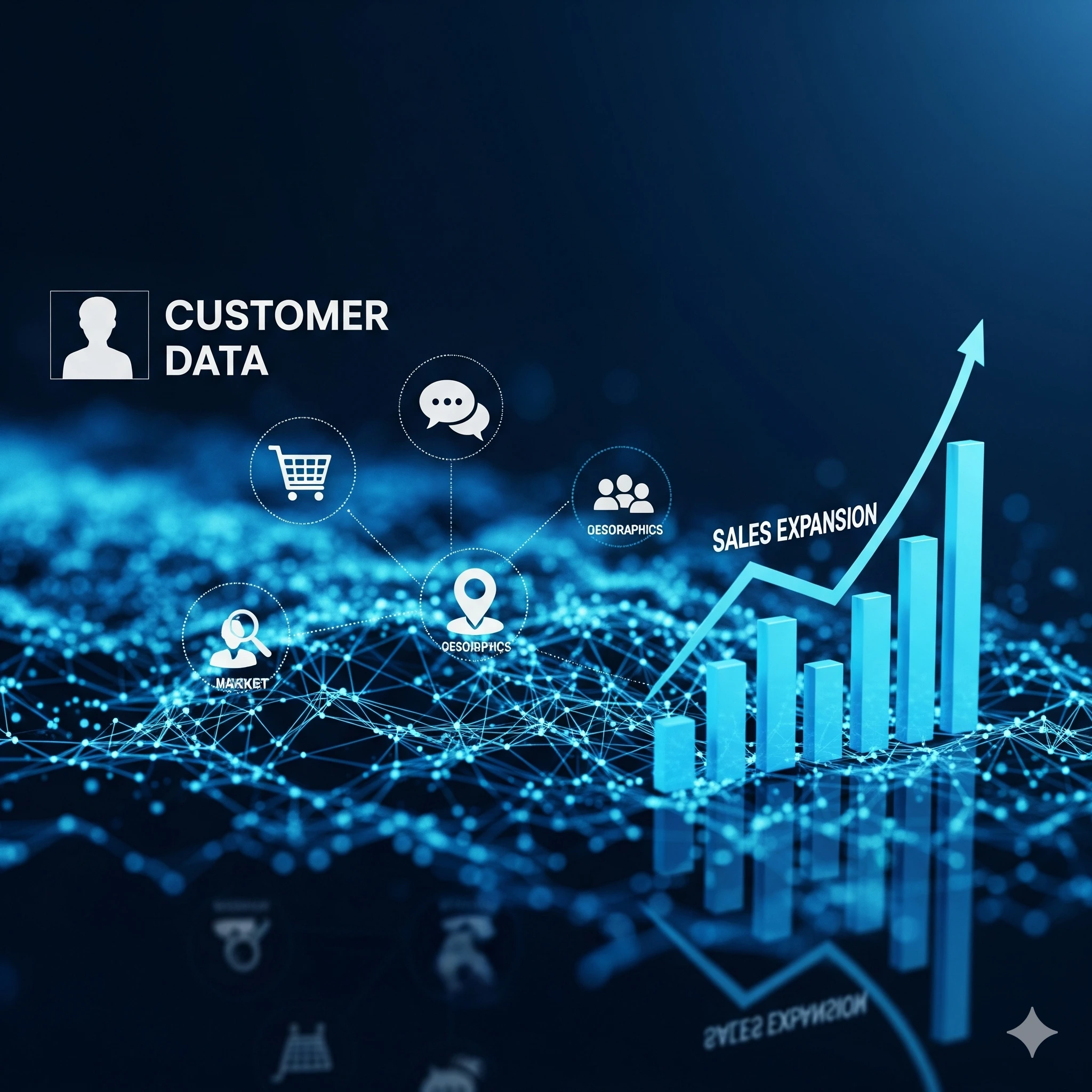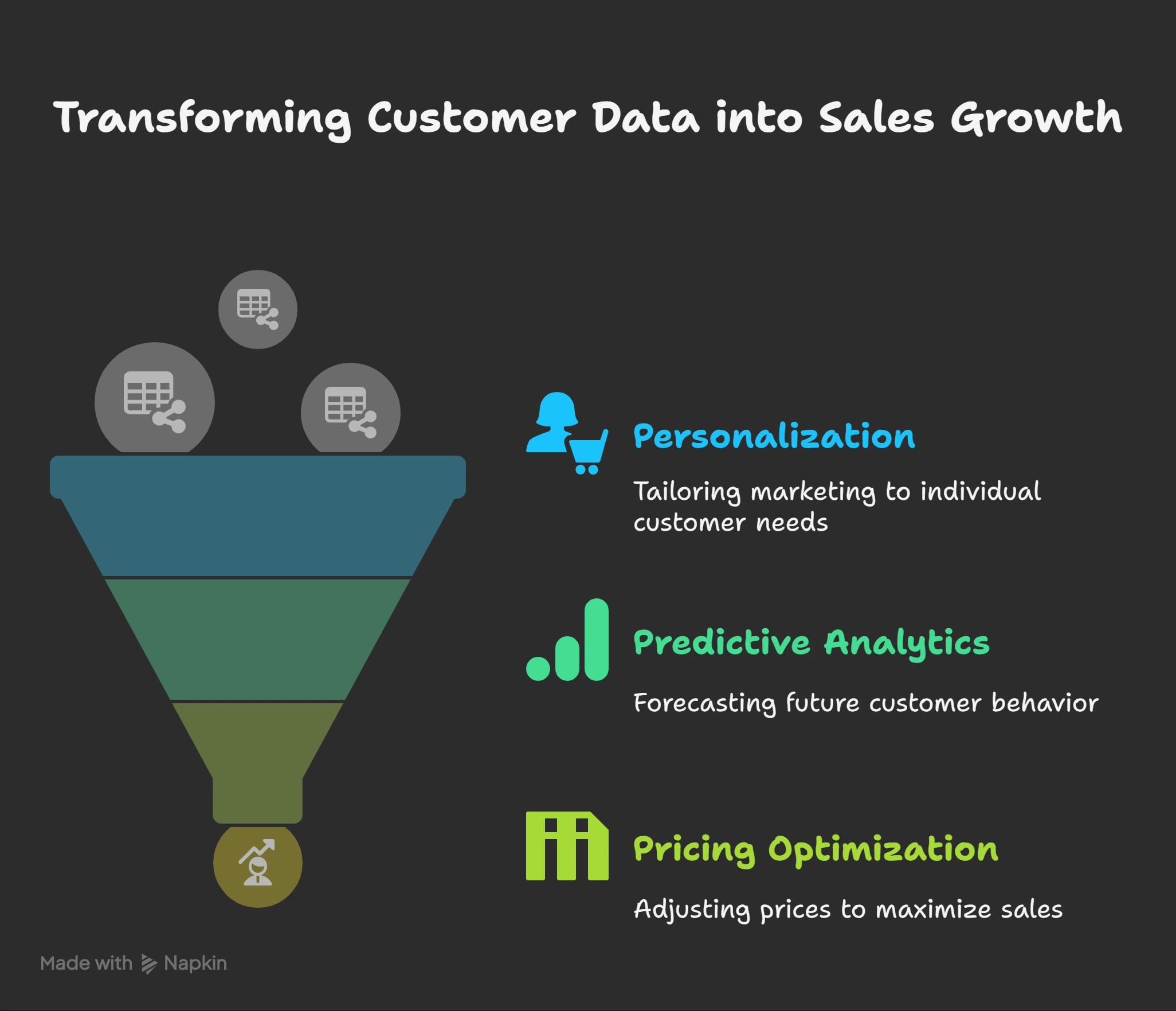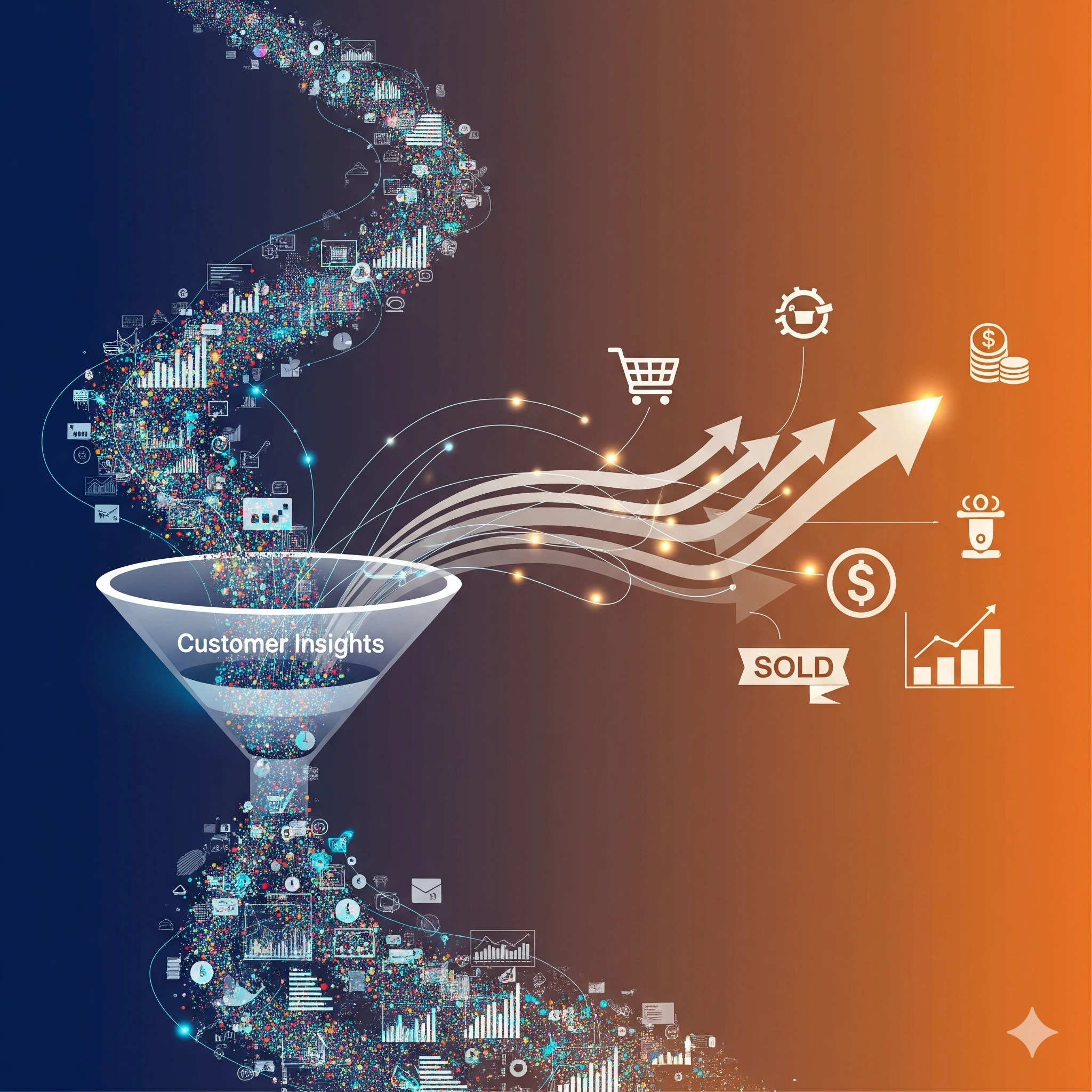
8 Ways to Leverage Customer Data for Sales Expansion | Complete Guide
Summary:
Customer data has become the backbone of modern sales strategies. From purchase history to behavioral patterns, every data point holds valuable insights that can help businesses connect with customers on a deeper level. When used correctly, customer data allows sales teams to craft targeted campaigns, improve engagement, and boost conversions without wasting resources.
In this guide, we’ll explore 8 powerful ways to leverage customer data for sales expansion. Whether it’s through personalization, predictive analytics, or optimizing pricing strategies, these data-driven methods will help you identify growth opportunities, retain loyal customers, and increase revenue.

Customer data for sales growth is the most potent business tool on the market today. By understanding what motivates your customers, you can make more intelligent sales choices and make better choices. Segmentation of purchasing behavior, engagement trends, and likes enables sales teams to identify high-value leads and boost conversions. Access to accurate information enables teams to predict buying behavior, customize outreach, and optimize the use of resources. Predictive analytics, combined with CRM tools like PowerDialer.ai, streamlines sales processes to become more focused, productive, and with better results. It's not about selling more, but building better customer experiences and revenue growth sustainably.
What is Customer Data?

Customer data refers to information that companies collect about their customers in order to understand what they are doing, what they are interested in, and what they require. It can be sourced from different places, like buying history, web interaction, ratings, and social media behavior. Collecting and analyzing customer data allows companies to make business decisions, maximize marketing campaigns, and maximize sales campaigns. Individualized experience, segmenting high-value customers, and predicting future trends are required. Customer information can be used by companies to streamline operations, reduce churn, and generate revenue in an economic way.
What to Remember:
- Demographics: Where they live, income level, age, gender
- Behavioral information: Browser behavior, purchase history, activity frequency
- Psychographics: Interests, lifestyle, values
- Transactional information: Product interest, purchase history, average order value
- Feedback & interactions: Ratings, support history, surveys
8 ways to Use Customer Data to Drive Sales Growth

Use of customer data is the ideal way of delivering sales growth and revenue. By monitoring your customers' purchasing history, taste, and behavior, you can come up with more advanced selling strategies that reach the correct customer at the correct time. By leveraging data insights, you can target contacts personally, identify high-value customers, price for best points, and enable accurate forecasting of sales. With predictive analytics and CRM products, organizations can make informed decisions based on data that will drive conversions, reduce churn, and empower more significant relationships. Leverage customer data to fuel growth in sales so your growth efforts are quantifiable, strategic, and results-oriented.
Benefits of Using Customer Data for Sales Growth:
- Aid campaigns targeting discrete customer segments
- Increased responsiveness and higher conversion rates
- Segmenting high-value customers for targeted actions
- Improved forecasting and most effective resource deployment
- Price optimization for maximal return
- Reduced churn and customer loyalty
1. Know Your Customer Segments
Segmentation forms the foundation of data-driven selling. By segmenting your customer base into high-value groups, you can learn about what drives different types of buyers. This enables sales teams to provide laser-targeted campaigns and messages, which are timely, context-specific, and compelling. Segmentation for the right purpose prevents wastage of effort on non-responsive consumers and optimizes marketing investment. By analyzing demographics, behavior, and psychographics, you can reveal latent opportunities and build offers that speak to them. RFM analysis makes it possible to identify high-value customers who must be treated with extra care. Proper segmentation also enables custom solicitation, intelligent forecasting, and higher long-term retention.
Why Customer Segmentation Matters
Segmented data enables companies to deliver tailored messages, engaging and converting more, while minimizing marketing spend.
Types of Customer Segmentation
- Demographic: Income, location, gender, age
- Behavioral: Participation patterns, buying history
- Psychographic: Lifestyle, values, interests
- RFM Analysis: Monetary value, frequency, recency
Tools to Analyze Segments
PowerDialer.ai, HubSpot, and Salesforce allow for automated segmentation with recommendations based on predictive analytics and customer behavior analysis.
Best Practices
- Refresh segmentation on new data regularly
- Blend segmentation types to develop insights of greater depth
- Use segmentation to power personalized outreach
Common Mistakes
- Over-segmentation makes the campaigns more difficult
- Leaving out the segmentation by behavioral patterns
For example, A SaaS company segmented users by adoption of features and offered feature-specific tutorials, which increased upsell revenue by 25%.
2. Customize Sales Outreach
With today's competitive landscape, mass messages just don't work. Customized sales outreach makes sure that your message is addressing your customers' interests and needs head-on. With customer information, sales representatives can compose emails, calls, and campaigns by specific activity, engagement, and buying actions. Personalization not only enhances engagement but also enhances confidence and deepens customer relationships over time. Personalization automation enables teams to scale activities without compromising personalization, automate time for high-value interactions. Data-driven personalization also provides sales teams with the ability to pre-triage customer needs and therefore maximize conversion opportunities. Segmentation and behavior-driven personalization make outreach extremely effective and results-oriented.
Personalized Messaging with Customer Data
Gain insights from past buying habits, engagement, and interests to create messages that speak to each user.
Examples of Personalized Campaigns
- Personalized product recommendation to a customer's purchase history
- Follow-up calls based on contact with the company
- Special offer to a treasured customer, using predictive analytics
Automation of Personalization
- Tips for Implementation
- Segmentation of the email list
- Personalization of subject lines and call scripts
- Automation, but beware of human touch
Advantages
- It will enhance the number of engagements
- Repeat purchases with a boost
- Customer loyalty increases
Mini Case Study: A retailer that used automated personalized emails discovered 20% of customers returned business within six months.
3. Identify High-Value Customers
Revenue is driven by high-value customers. Determining high-value customers early allows sales teams to target where they will be most effective. Customer data allows for analysis of frequency of purchase, activity level, and lifetime value, and therefore profitable account prioritization. Highly customized offers, loyalty programs, and VIP attention will most respond to high-value customers. Insights also reveal trends indicative of future high-value potential prospects. Investing in the relationship also increases top line as well as loyalty and long-term loyalty. Knowing the revenue-generating customers, businesses can plan on resources, promotion, and special care.
Customer Lifetime Value (CLV) Calculation
CLV assists in measuring the potential revenue of a customer, focusing efforts on revenue-generating customers.
VIP Customer Nurturing
- Special promotions and rewards
- Access to products early
- Special account managers allocated
Data-Driven Insights to Identify Patterns
A study of customer behavior pinpoints early warning signs of disengagement and engagement for optimal resource utilization.
Best Practices
- Monitor high-value customers regularly
- Provide customized rewards for enhancing loyalty
- Utilize predictive analytics to foresee needs
Benefits
- Optimizes revenues from the most valuable customers
- Enhances retention
- Minimizes risk of churn
Example: A software company revealed high-revenue clients who generated 40% of revenues and created a VIP support solution, increasing retention by 15%.
4. Simplify Sales Forecasting
Successful forecasting of sales is critical to planning and revenue predictability. Customer information provides a glimpse of past purchasing behavior, activity patterns, and seasonality patterns. Using predictive analytics, the sales force is aware of what demand will be in the future, invests resources appropriately, and avoids under- or over-staffing. Forecasting also informs marketing campaigns, inventory, and revenue targets. Using a CRM like PowerDialer.ai, forecasting is made precise, allowing a timely reaction to market fluctuation. Teams can combine historic information with live information, such that there can be proper planning. Lastly, sales teams can always stay vigilant, streamline operations, and capitalize on revenue streams.
Predicted Using Past Transactions
Compare transactions, seasonality, and engagement behavior with future performance.
Seasonal and Trend Analysis
- Identify off-season selling periods
- Forecast products' demand
- Maximize resource utilization
Effective forecasting tools
PowerDialer.ai provides predictive analytical dashboards for real-time forecasting.
How to forecast effectively
- Update your forecasts with new data on a regular schedule
- Qualitative feedback from sales reps with quantitative analysis
- Adjust plans based on seasonality and market conditions
Advantages
- Reduces forecasting errors
- Enhances resource allocation
- Facilitates revenue growth planning
Example: One B2B SaaS business utilized predictive analytics to predict Q4 subscriptions, outpacing revenue targets by 12%.
5. Enhance Lead Scoring
Lead scoring grades prospects by conversion likelihood. Through engagement metrics, demographics, and history of purchases, sales reps can prioritize the best opportunities. Automated lead scoring provides real-time updates, prompting reps to respond to most valuable prospects at all times. Data-driven scoring prevents wasted time and tightens the sales cycle. Predictive analytics extends further by identifying patterns that indicate buying preparedness. Through a methodical process, teams can increase conversion rates with better utilization of time and resources. Lead scoring also provides more meaningful follow-ups which appeal to prospects.
Components of Lead Scoring
- Frequency of interactions (calls, emails, visits to the site)
- Firmographics and demographics
- History of purchases
Lead Qualification through Automation
Automated solutions like PowerDialer.ai leverage real-time lead scores for intelligent prioritization.
Implementation Tips
- Regular review of scoring criteria
- Lead scoring tied to sales goals
- Add predictive analytics to guarantee precision
Advantages
- Improved conversion rates
- Lowered sales cycle
- Optimal usage of resources
Illustration: One company reduced time spent on low-value prospects by 35%, leading to higher overall revenue.
6. Improve Customer Retention
Customer retention costs less than customer acquisition. Customer data helps recognize at-risk customers by monitoring activity, buy rate, and satisfaction. Predictive analytics can also detect early churn signals, and this allows sales teams to intervene and act. Individualized follow-up, loyalty programs, and targeted promotion build better relationships and lifetime value. Monitoring feedback from reviews and surveys provides real-time insights for maximizing retention programs. Retention-oriented data also optimizes upselling and cross-selling efforts. By responding to insights based on data, businesses can ensure consistent revenue and increase customer loyalty.
Understanding Churn Patterns
Customer behavioral analysis picks up warning signs like decreased activity or purchase rate.
Data-driven retention efforts
Personalized follow-ups
- Loyalty programs
- Data-driven upsell and cross-sell campaigns
Maintaining Customer Satisfaction
Surveys, ratings, and feedback loops feed into retention efforts.
Best Practices
Segment at-risk customers for individualized contact
Use predictive analysis to act early
Track success measures to refine strategy
Benefits
- Companies see reduced churn
- Increases loyalty
- Drives repeat purchase
Example: A subscription business reduced churn by 10% through data-informed retention strategies.
7. Maximize Pricing Strategy
Pricing has a direct impact on revenue, and customer data allows for better decision-making. Examining purchase behavior, demand patterns, and segment data helps companies apply dynamic pricing and optimize profitability. Data-informed targeted pricing guarantees competitiveness and customer needs that offers meet. Second, data-informed pricing also helps identify opportunities in relation to promotions, discounts, and upselling. It can track trends and sentiments on segmentation using the capabilities of PowerDialer.ai and Tableau. Firms can maximize profitability and customer satisfaction simultaneously with the power of customer-insight-based pricing strategies.
Dynamic Pricing Models
Price adjustment needs to be dynamic based on demand, behavior, and insight.
Customer Insight Application
- Identify high-revenue segments
- Strategic discounting
- Price adjustment based on trend of behavior
Pricing Analytics Tools
PowerDialer.ai and Tableau provide insights to optimize pricing strategy.
Implementation Tips
- Compare prices to competitors on a regular basis
- Segment customers to aim products
- Track price effect on conversion
Advantages
- Maximizes revenue
- Increases customer satisfaction
- Enables strategic discounting
Example: A web business boosted monthly revenue by 15% through dynamic pricing.
8. Track Sales Performance
Sales performance measurement ensures constant improvement. Customer information enables tracking of leading measures such as conversion rates, deal size, and acquisition cost. Dashboards aggregate insights, and it is easier to identify patterns and likely areas for improvement. Predictive analytics ensures forecasting performance and maximizing strategies. Ongoing monitoring of KPIs enables sales teams to replicate success tactics and break weaknesses. Measuring performance also reveals top-performing reps and campaigns to reward and emulate. Data-driven measurement of performance ensures long-term revenue maximization and sales expansion.
Top Metrics to Measure
- Conversion rate
- Average deal size
- Lead response time
- Customer acquisition cost
Using Dashboards for Insights
Dashboards consolidate CRM analysis to uncover gaps and trends in real-time.
Continuous Improvement
Regular KPI checkup intervals enable teams to duplicate success and fix errors.
Implementation Tips
- Have measurable, achievable KPIs
- Make dashboards visible to the team for accountability
- Add predictive analytics to see deeper insight
Benefits
- Identify bottlenecks and opportunity
- Improves team efficiency
- Impacts long-term revenue growth
Illustration: Another SaaS firm increased conversion rates by 18% using dashboards and analytics.
Conclusion
Customer insights for revenue expansion allow businesses to make more informed, targeted, and results-driven decisions. With the use of segmentation, personalization, predictive analytics, and CRM insights, businesses can get improved conversion, better loyalty, and sustainable revenue expansion.
Prepare to turn your customer insights into real sales expansion. Book a demo today at PowerDialer.ai and find out how state-of-the-art CRM analytics can accelerate your sales performance.
FAQs
Q1: What is customer data in sales?
A1: Customer demographic, behavior, purchase, and preference data to inform sales strategy.
Q2: How does customer data improve sales performance?
A2: It enables segmentation, targeted outreach, predictive analysis, and KPI monitoring for optimized conversions.
Q3: What tools enable customer data analysis for sales growth?
A3: CRMs like Salesforce, HubSpot, and PowerDialer.ai, and data analysis tools like Tableau.
Q4: Is there any customer data privacy risk?
A4: Yes, compliance with GDPR, HIPAA, and other applicable laws.
Q5: How frequently should customer data be updated?
A5: Optimal real-time or monthly for maximum accuracy.
